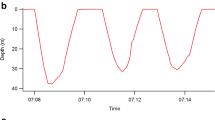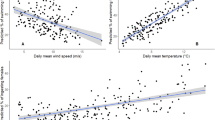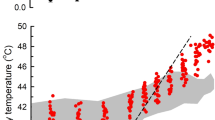Abstract
The ability to dive for long periods increases with body size1, but relative to the best human divers, marine birds and mammals of similar or even smaller size are outstanding performers. Most trained human divers can reach a little over 100 m in a single-breath dive lasting for 4 min (ref. 2), but king and emperor penguins (weighing about 12 and 30 kg, respectively) can dive to depths of 304 and 534 m for as long as 7.5 and 15.8 min, respectively3,4,5. On the basis of their assumed metabolic rates, up to half of the dive durations were believed to exceed the aerobic dive limit, which is the time of submergence before all the oxygen stored in the body has been used up4,6,7. But in penguins and many diving mammals7,8, the short surface intervals between dives are not consistent with the recovery times associated with a switch to anaerobic metabolism4. We show here that the abdominal temperature of king penguins may fall to as low as 11 °C during sustained deep diving. As these temperatures may be 10 to 20 °C below stomach temperature, cold ingested food cannot be the only cause of abdominal cooling. Thus, the slower metabolism of cooler tissues resulting from physiological adjustments associated with diving per se, could at least partly explain why penguins and possibly marine mammals can dive for such long durations.
This is a preview of subscription content, access via your institution
Access options
Subscribe to this journal
Receive 51 print issues and online access
$199.00 per year
only $3.90 per issue
Buy this article
- Purchase on Springer Link
- Instant access to full article PDF
Prices may be subject to local taxes which are calculated during checkout




Similar content being viewed by others
References
Kooyman, G. L. Diverse Divers(ed. Farner, D. S.) 1–200 (Springer, Berlin, (1989)).
Corriol, J. H.La Plongée en Apnée. Physiologie et Médecine 2nd edn(Masson, Paris, (1996)).
Kooyman, G. L. et al. Diving behavior and energetics during foraging cycles in king penguins. Ecol. Monogr. 62, 143–163 (1992).
Kooyman, G. L. & Kooyman, T. G. Diving behavior of emperor penguins nurturing chicks at Coulman island, Antarctica. Condor 97, 536–549 (1995).
Ancel, A. et al. Foraging behaviour of emperor penguins as a resource detector in winter and summer. Nature 360, 336–338 (1992).
Culik, B. M. et al. Diving energetics in king penguins (Aptenodytes patagonicus). J. Exp. Biol. 199, 973–983 (1996).
Kooyman, G. L. et al. Heart rates and swim speeds of emperor penguins diving under sea ice. J. Exp. Biol. 165, 161–180 (1992).
Boyd, I. L. & Croxall, J. P. Dive durations in pinnipeds and seabirds. Can. J. Zool. 74, 1696–1705 (1996).
Guinet, C. et al. Foraging behaviour of satellite-tracked king penguins in relation to the sea surface temperature obtained by satellite telemetry at Crozet Archipelago during the austral summer: a three year study. Mar. Ecol. Prog. Ser.(in the press).
Bost, C. A. et al. Foraging habitat and food intake of satellite-tracked king penguins during the austral summer at Crozet Archipelago. Mar. Ecol. Prog. Ser.(in the press).
Pütz, K. & Bost, C.-A. Feeding behavior of free-ranging king penguins (Aptenodytes patagonicus). Ecology 75, 489–497 (1994).
Wilson, R. P. & Culik, B. M. The cost of a hot meal: facultative specific dynamic action may ensure temperature homeostatis in post-ingestive endotherms. Comp. Biochem. Physiol. 100A, 151–154 (1991).
Wilson, R. P. et al. Reliability of stomach temperature changes in determining feeding characteristics of seabirds. J. Exp. Biol. 198, 1115–1135 (1995).
Pütz, K. Aspects of the feeding ecology of emperor penguins (Aptenodytes forsteri) and king penguins (Aptenodytes patagonicus). Rep. Polar Res. 136, 1–139 (1994).
Hill, D. R. et al. Heart rate and body temperature during free diving of Weddell seals. Am. J. Physiol. 253, R344–R351 (1987).
Ponganis, P. J., Kooyman, G. L., Castellini, M. A., Ponganis, E. P. & Ponganis, K. V. Muscle temperature and swim velocity profiles during diving in a Weddell seal, Leptenychotes weddellii. J. Exp. Biol. 183, 341–348 (1993).
Culik, B. M. et al. Core temperature variability in diving king penguins (Aptenodytes patagonicus): a preliminary analysis. Polar Biol. 16, 371–378 (1996).
Butler, P. J., Bevan, R. M., Woakes, A. J., Croxall, J. P. & Boyd, I. L. The use of data loggers to determine the energetics and physiology of aquatic birds and mammals. Braz. J. Med. Biol. Res. 28, 1307–1317 (1995).
Bevan, R. M. et al. Heart rate and abdominal temperatures of free-ranging South Georgian shags, Phalacrocorax georgianus. J. Exp. Biol. 200, 661–675 (1997).
Wilson, R. P., Cooper, J. & Plötz, J. Can we determine when marine endotherms feed? J. Exp. Biol. 167, 267–275 (1992).
Woakes, A. J., Butler, P. J., Bevan, R. M. & Boyd, I. L. The metabolic rate of free ranging antarctic animals. Biotelemetry XII 21, 3–223 (1992).
Woakes, A. J., Butler, P. J. & Bevan, R. M. Implantable data logging system for heart rate and body temperature: its application ot the estimation of field metabolic rates in Antarctic predators. Med. Biol. Eng. Comput. 33, 145–151 (1995).
Scholander, P. F., Irving, L. & Grinnel, S. W. On the temperature and metabolism of the seal during diving. J. Cell Comp. Physiol. 19, 67–78 (1942).
Bevan, R. M. & Butler, P. J. Cardiac output and blood flow distribution during swimming and voluntary diving of the tufted duck (Aythya fuligula). J. Exp. Biol. 168, 199–217 (1992).
Carey, F. G. A Companion to Animal Physiology(eds Taylor, C. R., Johnsen, K. & Bolis, L.) 216–235 (Cambridge Univ. Press, (1982)).
Kooyman, G. L., Wahrenbrock, E. A., Castellini, M. A., Davis, R. W. & Sinnett, E. E. Aerobic and anaerobic metabolism during voluntary diving in Weddell seals: evidence of preferred pathways from blood chemistry and behavior. J. Comp. Physiol. 138, 335–346 (1980).
Ketterson, E. D. & King, J. R. Metabolic and behavioral responses to fasting in the white-crowned sparrow (Zonotrichia leucophrys gambelli). Physiol. Zool. 50, 115–129 (1977).
Heldmaier, G., Steiger, R. & Ruf, T. Life in the Cold. Ecological, Physiological and Molecular Mechanisms(eds Carey, C., Florant, G. L., Wunder, B. A. & Horwitz, B.) 545–548 (Westview, Boulder, (1993)).
Ruf, T. & Heldmaier, G. The impact of daily torpor on energy requirements in the Djungarian hamster, Phodopus sungorus. Physiol. Zool. 65, 994–1010 (1992).
Heller, H. C., Elsner, R. & Rao, N. Voluntary hypometabolism in an Indian yogi. J. Therm. Biol. 12, 171–173 (1987).
Acknowledgements
We thank G. Froget, Y. Ropert-Coudert, J.-N. Clech and all the 1995 winter team in Crozet for their assistance in the field, and A. Ancel, C.-A. Bost, B. M. Culik and A. Malan for comments on the manuscript. After approval by the ethics committee of the Institut Français pour la Recherche et la Technologie Polaires, this study was supported by a grant for this Institute and by an NERC Small Research grant.
Author information
Authors and Affiliations
Corresponding author
Rights and permissions
About this article
Cite this article
Handrich, Y., Bevan, R., Charrassin, JB. et al. Hypothermia in foraging king penguins. Nature 388, 64–67 (1997). https://doi.org/10.1038/40392
Received:
Accepted:
Issue Date:
DOI: https://doi.org/10.1038/40392
This article is cited by
-
Behavioural adjustments during foraging in two diving seabirds: king and macaroni penguins
Marine Biology (2020)
-
Body surface rewarming in fully and partially hypothermic king penguins
Journal of Comparative Physiology B (2020)
-
Cold birds under pressure: Can thermal substitution ease heat loss in diving penguins?
Marine Biology (2016)
-
Lipid-induced thermogenesis is up-regulated by the first cold-water immersions in juvenile penguins
Journal of Comparative Physiology B (2016)
-
Challenges of measuring body temperatures of free-ranging birds and mammals
Animal Biotelemetry (2015)
Comments
By submitting a comment you agree to abide by our Terms and Community Guidelines. If you find something abusive or that does not comply with our terms or guidelines please flag it as inappropriate.



